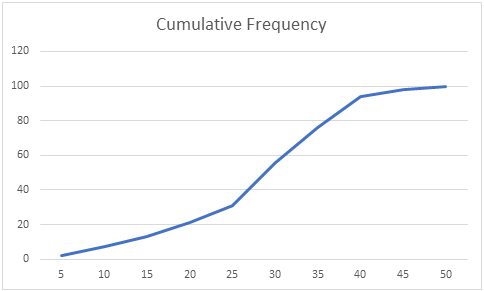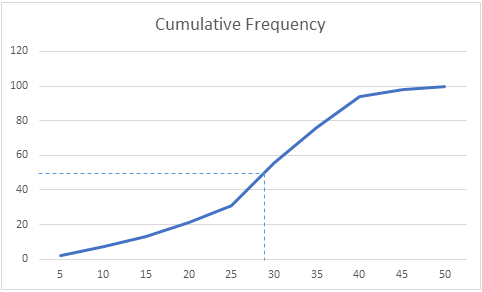
The marks obtained by 100 students of a class in an examination are given below.
Marks \[0 - 5\] \[5 - 10\] \[10 - 15\] \[15 - 20\] \[20 - 25\] \[25 - 30\] \[30 - 35\] \[35 - 40\] \[40 - 45\] \[45 - 50\] No. of Students $2$ $5$ $6$ $8$ $10$ $25$ $20$ $18$ $4$ $2$
Draw a less than type Cumulative Frequency Curve (Ogive). Hence Find the Median.
| Marks | \[0 - 5\] | \[5 - 10\] | \[10 - 15\] | \[15 - 20\] | \[20 - 25\] | \[25 - 30\] | \[30 - 35\] | \[35 - 40\] | \[40 - 45\] | \[45 - 50\] |
| No. of Students | $2$ | $5$ | $6$ | $8$ | $10$ | $25$ | $20$ | $18$ | $4$ | $2$ |
Answer
557.7k+ views
Hint: In this question we will convert the frequency table to a cumulative frequency table and plot the graph and then draw its ogive, and hence find the median.
Complete step-by-step solution:
To draw an ogive we require the cumulative frequencies of the values
The distribution table can be written as:
Now to find the Cumulative frequencies in a less than type cumulative frequency we add all the preceding terms to the current term, Therefore the cumulative frequency table could be written as:
Upon simplifying the above table, we get:
Now, we have to plot the graph with taking the upper limit of Marks on X-axis and the respective cumulative frequency on the Y-axis to get the less than ogive.
The points to be plotted to make a less than ogive are on the graph are: $(5,2),(10,7),(15,13),(20,21),(25,31),(30,56),(35,76),(40,94),(45,98),(50,100)$

The Curve in the above graph is the Cumulative Frequency Curve i.e. The ogive.
Now to find the median:
Let $N$ be the total number of students whose data is given.
Also $N$ will be the cumulative frequency of the last interval.
We find the ${\left[ {\dfrac{N}{2}} \right]^{th}}$ item (student) and mark it on the y-axis.
In this case the ${\left[ {\dfrac{N}{2}} \right]^{th}}$ item (student) is ${(100/2)^{th}}$ = ${50^{th}}$ student.
We draw a perpendicular from $50$ to the right to cut the Ogive curve.
From where the Ogive curve is cut, draw a perpendicular on the x-axis. The point at which it touches the x-axis will be the median value of the series as shown in the graph:

$\therefore $ From the above Graph we can see that the median is $29$
Hence we get the required answer.
Note: The cumulative frequency should always be plotted on the Y-axis to get a correct ogive.
There also exists a more than ogive, in this type of ogive while making the cumulative frequency table, all the succeeding terms in the distribution should be added to a term in the table.
Complete step-by-step solution:
To draw an ogive we require the cumulative frequencies of the values
The distribution table can be written as:
| Marks | No. of Students |
| \[0 - 5\] | $2$ |
| \[5 - 10\] | $5$ |
| \[10 - 15\] | $6$ |
| \[15 - 20\] | $8$ |
| \[20 - 25\] | $10$ |
| \[25 - 30\] | $25$ |
| \[30 - 35\] | $20$ |
| \[35 - 40\] | $18$ |
| \[40 - 45\] | $4$ |
| \[45 - 50\] | $2$ |
Now to find the Cumulative frequencies in a less than type cumulative frequency we add all the preceding terms to the current term, Therefore the cumulative frequency table could be written as:
| Marks | No. of Students | Cumulative Frequency |
| \[0 - 5\] | $2$ | $2$ |
| \[5 - 10\] | $5$ | $2 + 5$ |
| \[10 - 15\] | $6$ | $2 + 5 + 6$ |
| \[15 - 20\] | $8$ | $2 + 5 + 6 + 8$ |
| \[20 - 25\] | $10$ | $2 + 5 + 6 + 8 + 10$ |
| \[25 - 30\] | $25$ | $2 + 5 + 6 + 8 + 10 + 25$ |
| \[30 - 35\] | $20$ | $2 + 5 + 6 + 8 + 10 + 25 + 20$ |
| \[35 - 40\] | $18$ | $2 + 5 + 6 + 8 + 10 + 25 + 20 + 18$ |
| \[40 - 45\] | $4$ | $2 + 5 + 6 + 8 + 10 + 25 + 20 + 18 + 4$ |
| \[45 - 50\] | $2$ | $2 + 5 + 6 + 8 + 10 + 25 + 20 + 18 + 4 + 2$ |
Upon simplifying the above table, we get:
| Marks | No. of Students | Cumulative Frequency |
| \[0 - 5\] | $2$ | $2$ |
| \[5 - 10\] | $5$ | $7$ |
| \[10 - 15\] | $6$ | $13$ |
| \[15 - 20\] | $8$ | $21$ |
| \[20 - 25\] | $10$ | $31$ |
| \[25 - 30\] | $25$ | $56$ |
| \[30 - 35\] | $20$ | $76$ |
| \[35 - 40\] | $18$ | $94$ |
| \[40 - 45\] | $4$ | $98$ |
| \[45 - 50\] | $2$ | $100$ |
Now, we have to plot the graph with taking the upper limit of Marks on X-axis and the respective cumulative frequency on the Y-axis to get the less than ogive.
The points to be plotted to make a less than ogive are on the graph are: $(5,2),(10,7),(15,13),(20,21),(25,31),(30,56),(35,76),(40,94),(45,98),(50,100)$

The Curve in the above graph is the Cumulative Frequency Curve i.e. The ogive.
Now to find the median:
Let $N$ be the total number of students whose data is given.
Also $N$ will be the cumulative frequency of the last interval.
We find the ${\left[ {\dfrac{N}{2}} \right]^{th}}$ item (student) and mark it on the y-axis.
In this case the ${\left[ {\dfrac{N}{2}} \right]^{th}}$ item (student) is ${(100/2)^{th}}$ = ${50^{th}}$ student.
We draw a perpendicular from $50$ to the right to cut the Ogive curve.
From where the Ogive curve is cut, draw a perpendicular on the x-axis. The point at which it touches the x-axis will be the median value of the series as shown in the graph:

$\therefore $ From the above Graph we can see that the median is $29$
Hence we get the required answer.
Note: The cumulative frequency should always be plotted on the Y-axis to get a correct ogive.
There also exists a more than ogive, in this type of ogive while making the cumulative frequency table, all the succeeding terms in the distribution should be added to a term in the table.
Recently Updated Pages
Why are manures considered better than fertilizers class 11 biology CBSE

Find the coordinates of the midpoint of the line segment class 11 maths CBSE

Distinguish between static friction limiting friction class 11 physics CBSE

The Chairman of the constituent Assembly was A Jawaharlal class 11 social science CBSE

The first National Commission on Labour NCL submitted class 11 social science CBSE

Number of all subshell of n + l 7 is A 4 B 5 C 6 D class 11 chemistry CBSE

Trending doubts
What is meant by exothermic and endothermic reactions class 11 chemistry CBSE

10 examples of friction in our daily life

One Metric ton is equal to kg A 10000 B 1000 C 100 class 11 physics CBSE

1 Quintal is equal to a 110 kg b 10 kg c 100kg d 1000 class 11 physics CBSE

Difference Between Prokaryotic Cells and Eukaryotic Cells

What are Quantum numbers Explain the quantum number class 11 chemistry CBSE




